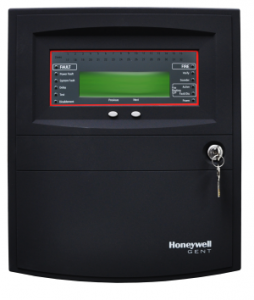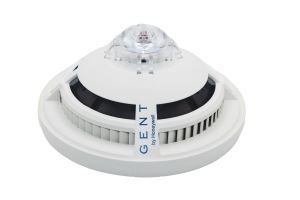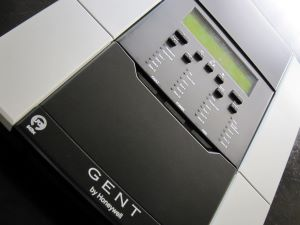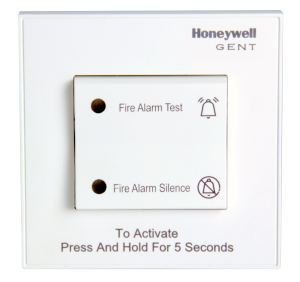HONEYWELL GENT
Suppliers of: Complete Fire Detection systems, Commercial Fire Alarm systems, Voice Alarm systems, Fire Detection products, Commercial Fire Alarms, Commercial Voice Alarms, Emergency Lighting products, Fire Detection Consultancy, Emergency Lighting
Honeywell Gent, formerly Gents’ of Leicester, is a British manufacturer of life safety equipment based in Leicester. With over 150 years of experience, it is a leading manufacturer of innovative and flexible fire detection products.
Honeywell Gent’s fire detection systems are developed to the highest possible standards. As a market leader, we have a broad range of Analogue Addressable and Conventional fire detection systems. In addition to this, we have built up our expertise in Voice Alarm systems and have a range of systems to suit to most applications.
Gent has developed an extensive set of BIM models to support the ever growing demand - one of the first fire equipment manufacturers to provide BIM models. In addition, a full range of 2D CAD drawings are also available to support traditional building design techniques.
Honeywell Gent offer the following Product Ranges:
Honeywell Gent’s Vigilon system is the most comprehensive life safety system available in the market today. The combination of the powerful software in the control panel and the intelligent loop powered devices delivers a flexible, easy to use system for all types of buildings. The Vigilon system offers a complete range of control panels that can be installed as standalone panels from 1 to 6 loops or as part of multi-panel networks.
The strength of Vigilon and Nano lies in the combination of powerful control panel software with Honeywell Gent’s market-leading range of intelligent devices. All devices are loop powered, delivering a flexible, streamlined system in any type of building. Requiring just a single two-core cable to connect the loop, every device includes an integral short circuit isolator to reduce installation cost and increase system integrity.
Repeat and Mimic panels for easy operation.
Connected Life Safety Services (CLSS)
What if you could transform the way fire systems are commissioned, monitored and maintained with one tool? Honeywell CLSS places connectivity at the heart of fire safety, providing real-time visibility to enhance timely, accurate decision making.
Conventional Fire Detection Systems
From control panels through to Manual Call Points, Detectors, Bells, Door Releases and Sounders, Honeywell Gent provides a cost effective Conventional fire detection system, scalable for sites of all types. With the Xenex control panel at its hub, Gent can cover up to eight zones. Integrated with the low-current S-Cubed range of sounders incorporating sound, speech and strobe in a single device, Gent ensures each site has high levels of coverage with above average response rates during an emergency.
Honeywell Gent’s range of Aspirating Smoke Detection, also known as Air Sampling Detection (ASD) systems can detect fires at an incredibly early stage, often before visible smouldering takes place, before an open fire occurs and before intense smoke develops.
OSID (Open Area Smoke Detection)
OSID provides reliable, cost-effective smoke detection for open spaces where fire detection presents unique challenges and where early warning is not always the priority.
The Honeywell Conventional Flame Detection range comprises of 2 families: the FSX range being suitable for industrial type applications, Zone 1 hazardous area units and the FSL range being Zone 2 hazardous area units.
Voice Alarms and Loudspeakers
Honeywell Gent offers a complete range of Voice Alarm systems integrated with the Vigilon Detection system to suit a wide range of sites and applications.
Emergency Voice Communications
An Emergency Voice Communication System (EVCS) is a fixed, secure, bi-directional, full duplex voice communication system to assist fire fighters during emergencies in high rise buildings or large sites where radio communication cannot be guaranteed to work due to interference from the fire corona.
WINMAG Graphics Management System is an invaluable software tool for any size of network that allows for complete management of the fire detection and alarm system from a central PC.
The Li-ion Tamer Rack Monitoring system is a device that monitors lithium-ion battery off-gas events. Off-gas events occur early in the failure mode of lithium-ion batteries and very early detection of these events allow proper mitigation steps to be taken to avoid a catastrophic thermal runway failure.
The Response Paging System offers the latest innovations in wireless paging and monitoring. It’s a cost effective and flexible paging system that offers the ability to quickly respond to activated alarms.
Discover Honeywell Gent’s latest range of fire Ancillary Devices.
Further technical information is available to download from the BPi download library of from the Manufacturer’s own website.
AFTER GRENFELL – EMPOWERING DIGITAL FIRE SAFETY
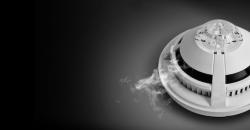 Why is BS 8644-1 Crucial for Business Owners and Facility Managers?
Why is BS 8644-1 Crucial for Business Owners and Facility Managers?
THE ROLE OF GRENFELL IN CHANGING FIRE SAFETY STANDARDS
The Grenfell Tower fire disaster in 2017, which claimed 72 lives, marked a turning point in UK fire safety standards1. This prolific event highlighted critical gaps in fire safety management, leading to comprehensive reforms aimed at improving accountability and transparency. One significant outcome was the introduction of BS 8644-1 in 2022, a standard that emphasises the digital management of fire safety information throughout a building’s lifecycle. By promoting accurate, accessible, and consistent data, BS 8644-1 supports more robust safety practices and enhances compliance across the built environment.
WHO IS RESPONSIBLE FOR FIRE SAFETY?
Under the Fire Safety Act 2021, building owners, managers, and designated Responsible Persons (RPs) are required to:
Ensure a fire risk assessment is completed by a competent person
Ensure fire safety systems are maintained by a competent person
Inform occupants about evacuation procedures
HOW DOES BS 8644-1 HELP?
BS 8644-13 outlines best practices for the digital management of fire safety information across all stages of a building’s lifecycle.
Following the Grenfell Tower fire, Dame Judith Hackitt’s independent review identified widespread issues with the creation, maintenance, and handover of critical safety records, calling for a unified approach known as the “golden thread”. This concept ensures that essential fire safety data remains accurate, accessible, and relevant from design through to a building’s end of life, fostering greater accountability and transparency.
The standard addresses longstanding concerns, such as inadequate record-keeping and unclear accountability, by mandating consistent digital documentation to support safer building operations. UK business owners and facility managers must recognise that this standard is not just about regulatory compliance – it’s about safeguarding lives and protecting assets.
WHAT IS THE COST OF FIRE DETECTION SYSTEM FAILURES?
False alarm incidents continue to be a major challenge, with UK Government statistics reporting 254,000 cases in the year ending September 2024, the highest number since 2011. These disruptions burden emergency services, impact businesses and may cause people to become less responsive to real fire emergencies.
Common causes include:
Poor detector placement or incorrect device selection
Inadequate maintenance or testing
Deliberate tampering or power failures
Faulty equipment accounted for 118,115 false alarms, marking a 20% increase over five years. These figures underscore the importance of proper system maintenance, effective design, and compliance with fire safety standards to mitigate risks and ensure reliable operation.
HOW DOES THE DIGITAL SHIFT ENHANCE FIRE SAFETY COMPLIANCE?
Technology, such as Honeywell’s cloud-based maintenance app (CLSS) and automated fire detectors (Self-Test), provide a transformative, digital approach to managing fire safety:
Remote Monitoring & Real-Time Alerts: These solutions offer instant insights into fire system status and performance, reducing downtime and false alarms.
Automated Functional Testing: Self-Test detectors allow for regular, accurate checks that consistently meet BS 5839-1 standards.
Digital Documentation: Cloud-based record-keeping establishes a continuous “golden thread” that documents every stage of the building lifecycle.
HOW DO CONNECTED SOLUTIONS SUPPORT THE BS 8644-1 BUILDING LIFECYCLE?
BS 8644-1 recommends digital management at every stage of a building’s life. Honeywell’s connected solutions integrate seamlessly into each phase.
Briefing and Design
Fire risk assessment and strategy should be at the core of every fire system design. Yet, long-term compliance and daily challenges are often overlooked. Daily issues such as accessibility for testing, fire monitoring during testing, and regular reporting and compliance updates are common. The pressure to cut initial installation costs may lead to choosing lower-specification non-connected devices, increasing long-term maintenance costs.
Construction
Construction projects frequently limit the time allocated for proper fire system commissioning. Honeywell’s Self-Test detectors automate testing even in challenging environments, ensuring that systems are fully compliant before handover. Digital logs capture every test and adjustment, providing an auditable trail that supports both compliance and operational efficiency.
Asset Handover
Asset handover involves demonstrating the functionality of the system to the relevant stakeholders, including building owners, regulatory authorities or their representatives. Accurate documentation, including test results, commentary and pictures of fire devices and their locations, help capture the condition of the system that is being handed over – creating a digital timestamp and a baseline for future maintenance. The asset handover should ensure clear accountability across all phases of a building’s lifecycle.
Asset in Use
For operational buildings, continuous system monitoring is critical. Honeywell’s cloud‑based solutions provide real‑time oversight and automated functional testing to identify any changes or degradation in system performance. This continuous monitoring reduces the risk of system failures and minimises disruption to building occupants.
Asset End of Life
Fire safety systems eventually require replacement or upgrading. Connected solutions enable predictive maintenance by providing alerts when components approach the end of their effective life. This proactive strategy ensures timely upgrades, prevents sudden failures, and helps maintain continuous compliance – all while supporting long-term budget planning.
HOW CAN YOU FUTUREPROOF YOUR FIRE SAFETY STRATEGY?
Protecting buildings and their occupants is non-negotiable. Digital fire safety isn’t optional; it’s a strategic priority. Honeywell continually invests in new technologies designed to meet the real-world challenges faced by UK businesses. By adopting new innovations, such as Honeywell CLSS and Self-Test, UK business owners and facility managers can:
Reduce Operational Risks: Implement continuous monitoring and maintenance of fire safety systems.
Meet & Exceed Compliance: Maintain a complete, digital audit trail that meets and exceeds the latest regulatory standards.
Secure Long-Term Savings: Avoid the financial and reputational costs associated with outdated, manual systems.
Enhance Safety: Real-time alerts and digital record-keeping protect both occupants and assets.
TAKE THE NEXT STEPS IN SAFEGUARDING YOUR BUILDING
BS 8644-1 sets a new standard for fire safety management through digital innovation. By integrating connected technologies, organisations can achieve greater safety, compliance, and operational efficiency. Digital transformation effectively addresses the challenges identified from previous shortcomings, paving the way for a more resilient, accountable fire safety landscape.
Connect with Honeywell for a free consultation about the impact of BS 8644-1 on your buildings, and how you can not only meet these standards, but exceed them.
The Honeywell Self-Test Revolution
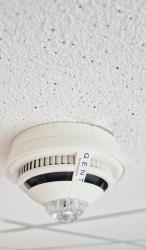 How is Honeywell revolutionising fire system testing and maintenance with innovative technology?
How is Honeywell revolutionising fire system testing and maintenance with innovative technology?
Building developers and building owners face many responsibilities and challenges when it comes to fire safety, particularly in multi-occupied settings. Advancements in fire safety technology are constantly evolving to meet these challenges and Honeywell Self-Test is the ground-breaking innovation that is revolutionising fire system maintenance.
In complex buildings and facilities, how can you prove that your fire system is compliant and that every single detector has been functionally tested, even in lift shafts, stairwells, and inaccessible rooms?
Traditional fire testing with a smoke pole and cup can be labor-intensive, while fire maintenance frequently disrupts daytime operations or incurs costly out-of-hours activities. Both scenarios are prone to inaccuracies due to access issues in complex buildings and the requirement to isolate the fire panel during testing, introducing additional risk.
Self-Test automates fire system maintenance and does not require physical access to locked rooms to perform functional fire tests. Self-Test eliminates the need for ladders, scaffolding, and scissor lifts to reach hard-to-access detectors, avoiding potential safety hazards, and reduces the need for out-of-hours testing. By automating functional fire testing, competent engineers can focus more time on thorough visual inspections to remain compliant.
How does Honeywell Self-Test work?
Self-Test detectors feature an internal module that generates smoke, allowing for functional testing of the optical sensor. A small fan expels the smoke through designated entry points, ensuring unobstructed detection in the event of a real fire. Additionally, the system includes an internal thermistor for safe heat sensor testing.
With the integration of an internal Bluetooth Low Energy Emitter (BLE), detectors seamlessly connect to a mobile app, enabling engineers to efficiently locate and inspect devices throughout a building while ensuring a discreet and non-invasive on-site presence.
With Self-Test, building owners can now prove that their fire detection systems undergo multiple tests a year, exceeding the prescribed once-a-year testing requirement by British Standard BS 5839-1.
The intuitive Honeywell Connected Life Safety Services (CLSS) app offers a wide range of testing options tailored to specific building needs, emphasising efficiency and speed. Capture essential events, test results, and visual inspection information – enabling engineers to identify necessary corrective actions more effectively.
Traditionally, fire testing documentation relied on printed results, leaving room for dispute. The CLSS app captures all Self-Test activities, including the manual testing and visual inspection commentary with accompanying photographs. CLSS also records daily events, creating a comprehensive digital logbook stored securely in the cloud. This digital logbook ensures no information is lost, providing invaluable historical records for fault investigation and false alarm analysis.
DID YOU KNOW?
Self-Test is capable of functionally testing any size fire system in 35 minutes or less
Paving the way for digital transformation
As the sector continues to evolve, the need for digital solutions and streamlined fire safety maintenance processes increases. Honeywell’s Self-Test technology represents a forward-looking approach to fire safety, offering a future-proof solution for maintaining compliance and ensuring life safety in commercial and institutional settings.
Find out more: https://buildings.honeywell.com/gb/en/brands/our-brands/gent/solutions/gent-self-test







